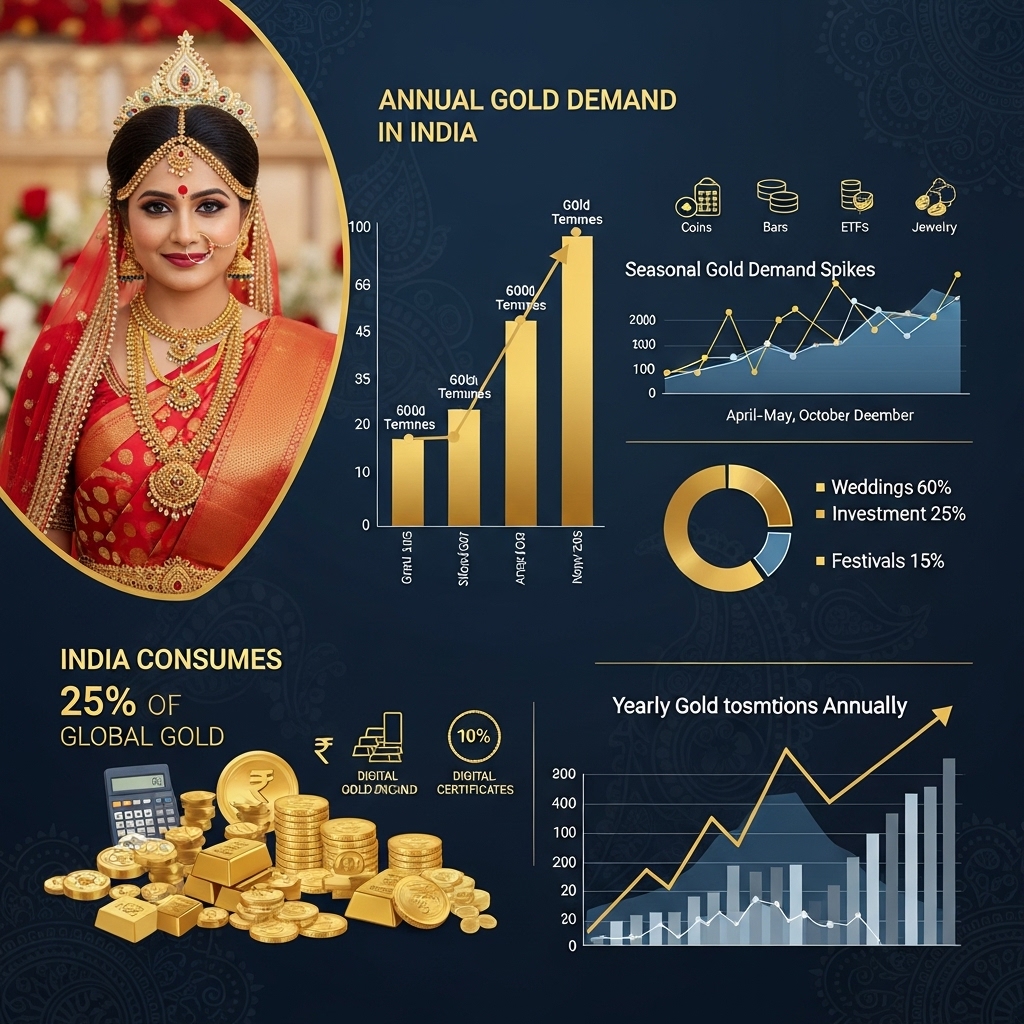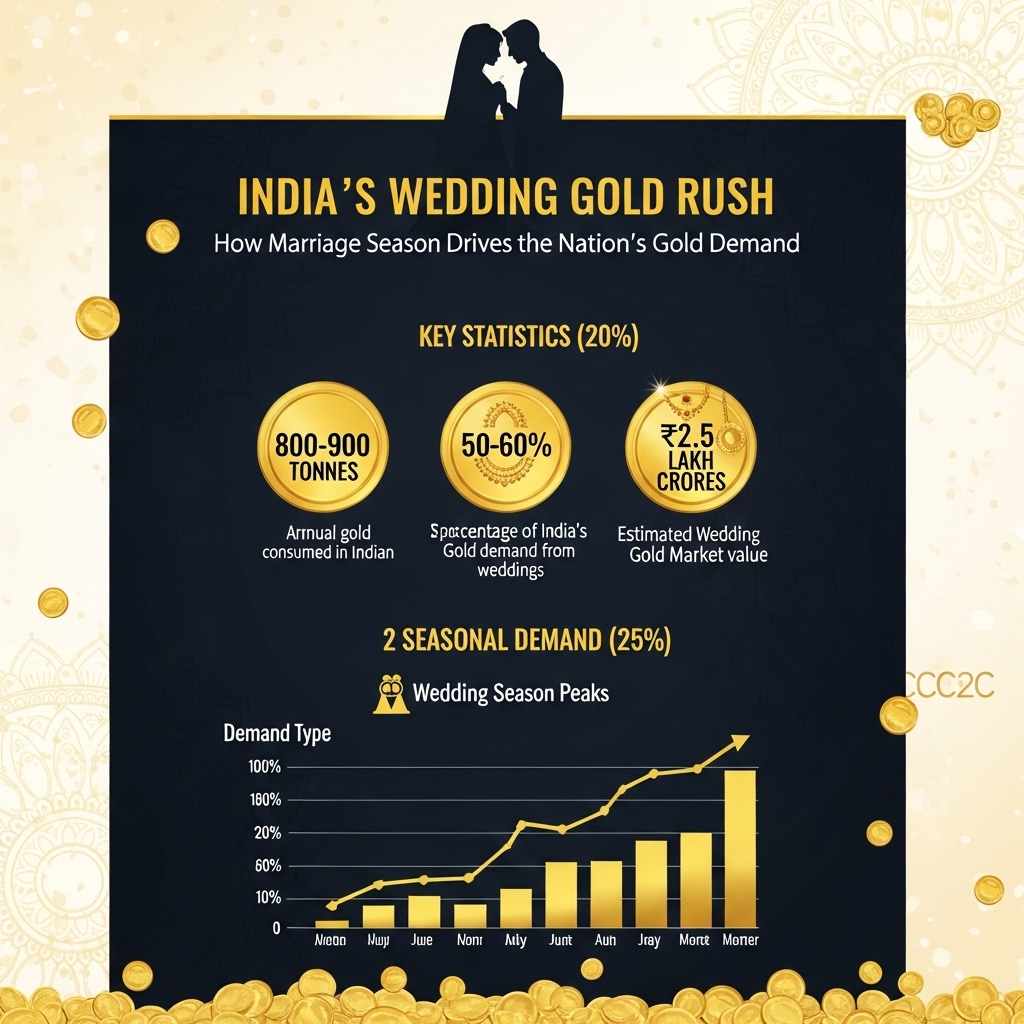How Indian Weddings Create a $15 Billion Annual Gold Rush – And Why Smart Investors Pay Attention
Picture this: while Western markets experience their typical seasonal lulls, gold prices suddenly surge by 10-15% seemingly out of nowhere. The culprit? Five million Indian weddings happening simultaneously during peak wedding season, creating a gold demand tsunami that ripples through global markets every single year.
India consumes nearly 25% of the world’s gold annually, with wedding-related purchases accounting for a staggering 50% of this demand. This isn’t just cultural tradition—it’s a predictable market force that savvy investors leverage for portfolio gains. During peak wedding months (October through December and April through June), Indian gold imports can spike by up to 40%, directly impacting international gold prices and creating profitable opportunities for those who understand these patterns.
In this comprehensive analysis, we’ll decode how India’s wedding calendar drives global gold markets, explore the seasonal price patterns every investor should know, and reveal strategic timing opportunities for gold investments. We’ll examine why Indian wedding gold purchases are recession-proof, how government policies amplify or dampen this demand, and most importantly, how you can position your portfolio to benefit from the world’s most predictable gold buying spree.
For gold investors, understanding India’s wedding-driven demand cycles isn’t optional—it’s essential for maximizing returns in an increasingly volatile precious metals market. Let’s dive into the golden opportunity hiding in plain sight.
Gold Market Analysis and Key Insights
Wedding Season Impact on Gold Prices
India’s wedding seasons create predictable gold demand surges, with prices typically rising 3-8% during peak months (October-December and April-May). The Reserve Bank of India reports that wedding-related purchases account for approximately 35-40% of annual gold consumption, making matrimonial demand a crucial price driver. Jewelers often increase inventory by 25-30% ahead of wedding seasons, creating additional market pressure.
Investment Benefits During Wedding Seasons
Gold’s dual role as both ornament and investment makes wedding purchases particularly attractive. During 2023, gold delivered 13% returns in rupee terms, outperforming many traditional investments. Wedding gold purchases offer immediate utility while serving as long-term wealth preservation. The cultural acceptance ensures high liquidity, with families often using wedding gold as collateral for future financial needs.
Current Market Trends and Data
Recent data shows Indian gold imports reached 800-900 tonnes annually, with 60-65% consisting of jewelry demand. Digital gold platforms have emerged as alternatives, allowing fractional wedding gold purchases starting from ₹1. Exchange-traded funds (ETFs) and gold bonds provide paperless options for wedding-related gold investments, growing 40% year-over-year among urban consumers.
Strategic Investment Considerations
Timing wedding gold purchases requires careful market analysis. Experts recommend dollar-cost averaging through systematic gold purchases months before wedding dates. Import duty fluctuations (currently 10-15%) significantly impact final costs, making timing crucial. Consider allocating 5-10% of wedding budgets to pure investment gold alongside ornamental purchases.
Expert Recommendations
Financial advisors suggest diversifying wedding gold investments across physical jewelry, digital gold, and paper gold instruments. Purchase from certified jewelers ensuring hallmark compliance and proper documentation for future liquidity. Consider gold accumulation plans offered by major jewelers, allowing gradual purchases at fixed intervals. Monitor global gold trends and rupee movements, as international prices and currency fluctuations directly impact local rates, potentially saving 5-10% on wedding gold expenses through strategic timing.

Gold Investment Strategies and Options
Understanding India’s wedding-driven gold demand patterns enables investors to develop sophisticated investment strategies that capitalize on seasonal market trends while building long-term wealth.
Physical Gold Investment Options
Traditional jewelry remains popular but carries high making charges (15-25%). Gold coins and bars offer better value with minimal premiums, while sovereign gold bonds (SGBs) provide 2.5% annual interest plus capital appreciation without storage concerns.
Modern Investment Vehicles
Gold ETFs and mutual funds offer liquidity and eliminate storage costs, making them ideal for portfolio diversification. Digital gold platforms enable fractional ownership starting from ₹1, perfect for systematic investment plans (SIPs) aligned with wedding seasons.
Risk Assessment and Allocation
Financial experts recommend 5-10% gold allocation in diversified portfolios. Gold’s negative correlation with equities provides hedge against inflation and currency devaluation. However, gold generates no dividends, making it purely a capital appreciation play.
Strategic Market Timing
Wedding seasons (October-December and April-May) typically drive prices higher due to increased demand. Savvy investors accumulate during monsoon months (June-September) when demand traditionally weakens. Akshaya Tritiya and Dhanteras present buying opportunities despite premium pricing.
Comparative Analysis
SGBs offer the best long-term returns with tax benefits on maturity. ETFs provide superior liquidity for short-term strategies. Physical gold suits investors prioritizing tangible assets and cultural significance.
Investment Approach
Dollar-cost averaging through SIPs helps navigate volatility. Combining physical gold for weddings with paper gold for investment optimizes returns. Monitor rural income patterns, monsoon forecasts, and festival calendars to anticipate demand fluctuations and position accordingly.
Market Performance and Outlook
India’s wedding-driven gold demand has demonstrated remarkable resilience over the past decade, consistently accounting for 25-30% of global gold consumption. Historical data reveals that wedding seasons (October-December and April-May) typically see 40-50% spikes in gold purchases, with annual wedding gold consumption averaging 350-400 tonnes.
Recent market conditions show a shift in purchasing patterns. Despite gold prices reaching ₹65,000 per 10 grams in 2023, wedding gold demand remained robust at 315 tonnes, indicating strong cultural adherence despite price sensitivity. Digital gold purchases and lightweight jewelry designs have emerged as adaptive strategies among younger couples.
Economic factors significantly influence wedding gold demand. Rupee depreciation, inflation rates, and monsoon performance directly impact purchasing power. Import duty fluctuations, currently at 10%, affect retail prices and buying decisions. Rising disposable incomes in Tier-2 and Tier-3 cities have offset urban market slowdowns.
Future outlook suggests steady growth driven by demographic dividends. With 10-12 million weddings annually and increasing per-capita spending, wedding gold demand is projected to reach 380-420 tonnes by 2025. However, evolving preferences toward experiential weddings and sustainable jewelry may moderate traditional heavy gold purchases.
Market analysts predict gold prices will stabilize between ₹60,000-₹70,000 per 10 grams, making wedding purchases more predictable. The digitization of gold buying and flexible payment options will likely sustain demand despite economic uncertainties.
Frequently Asked Questions About Gold Investment
How much gold demand do Indian weddings generate annually?
Indian weddings drive approximately 400-500 tonnes of gold demand yearly, representing 60-70% of India’s total consumer gold consumption. This massive seasonal demand typically peaks during wedding seasons from October to December and April to June, creating significant price fluctuations that smart investors monitor closely.
Why should gold investors track wedding seasons?
Wedding seasons create predictable demand spikes, often driving gold prices up 5-15% during peak months. Savvy investors buy gold during off-seasons (July-September) when wedding demand is lowest, then potentially benefit from seasonal price appreciation during wedding months.
Do wedding gold purchases affect long-term gold prices?
Yes, India’s consistent wedding-driven demand provides a strong price floor for gold globally. This cultural constant makes Indian wedding gold one of the most reliable demand drivers worldwide, offering investors confidence in gold’s long-term stability.
Which regions drive the highest wedding gold demand?
South India (Tamil Nadu, Kerala, Karnataka) and West India (Maharashtra, Gujarat) account for 65% of wedding gold purchases. Regional festivals and wedding customs significantly impact local gold prices, creating geographic arbitrage opportunities.
How do investors capitalize on wedding gold demand patterns?
Experienced investors accumulate gold during monsoon months when wedding activity is minimal, then either hold through wedding seasons for appreciation or sell during peak demand periods for 8-12% seasonal gains.

Final Thoughts on Gold Investment
India’s wedding season represents a powerful, predictable force in global gold markets that savvy investors cannot afford to ignore. The cultural significance of gold in Indian marriages creates consistent demand spikes between October and December, offering strategic timing opportunities for portfolio positioning.
Key takeaways for investors:
– Wedding-driven demand accounts for 40-50% of India’s annual gold consumption
– Seasonal price patterns emerge during peak wedding months
– Cultural traditions ensure sustained long-term demand regardless of economic fluctuations
Investment recommendation: Consider accumulating gold positions before India’s wedding season begins, typically by September, to capitalize on anticipated demand increases.
Gold’s role in Indian weddings isn’t just cultural—it’s an economic engine that creates measurable market opportunities. Whether you’re a seasoned investor or exploring precious metals for the first time, understanding this annual cycle can enhance your investment strategy.
Ready to add gold to your portfolio? Research reputable dealers and start positioning yourself for India’s next wedding season today.